Crikey! It’s a big land Down Under—full of wild animals that can kill you, outback that challenges you to survive, and beautiful Aussie beaches to make you weep!
Why would you only want to play cards with such an array of fun at your fingertips?
Here are some enticing places to go:
The Olympics Site (site of the Pro Circuit)
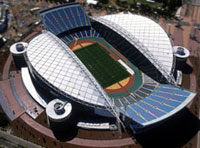 Sydney was awarded the 2000 Olympics on September 23, 1993. The purpose-designed Homebush Visitors Centre has a comprehensive display featuring the history of the local area and the history of the Olympics site. It is open from 9:00 AM to 5:00 PM every day.
Sydney was awarded the 2000 Olympics on September 23, 1993. The purpose-designed Homebush Visitors Centre has a comprehensive display featuring the history of the local area and the history of the Olympics site. It is open from 9:00 AM to 5:00 PM every day.
Opera House
 People often think of the Sydney Opera House as just a single opera theater. In fact, it has five theaters—a concert hall, an opera theater, a drama theater, a cinema, and a recording hall—as well as two restaurants, a number of bars, six lounges, a library, five rehearsal studios, and sixty-five dressing rooms. There are regular one-hour guided tours of the building that are conducted every half-hour between 9:00 AM and 5:00 PM daily. Backstage tours occur daily at 7:00 AM and last for two hours.
People often think of the Sydney Opera House as just a single opera theater. In fact, it has five theaters—a concert hall, an opera theater, a drama theater, a cinema, and a recording hall—as well as two restaurants, a number of bars, six lounges, a library, five rehearsal studios, and sixty-five dressing rooms. There are regular one-hour guided tours of the building that are conducted every half-hour between 9:00 AM and 5:00 PM daily. Backstage tours occur daily at 7:00 AM and last for two hours.
The Harbour Bridge
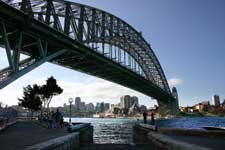 No visit to Sydney can be considered complete without a leisurely walk across Sydney Harbour Bridge. Or better yet, do the Bridgeclimb, where you walk over the top of the bridge. The adventure is not cheap and not for the fainthearted, but it does offer the best views of Sydney. It also offers you the chance to say that you’ve done it.
No visit to Sydney can be considered complete without a leisurely walk across Sydney Harbour Bridge. Or better yet, do the Bridgeclimb, where you walk over the top of the bridge. The adventure is not cheap and not for the fainthearted, but it does offer the best views of Sydney. It also offers you the chance to say that you’ve done it.
The Rocks
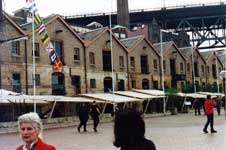 Although now predominantly a tourist attraction consisting of historic pubs, restaurants, and chic gift shops, it is still possible (particularly if you explore beyond the main streets) to see that in the 18th and 19th centuries, this was the center of the city’s wild military and convict nightlife. The area has a wide range of free shows and a number of interesting galleries.
Although now predominantly a tourist attraction consisting of historic pubs, restaurants, and chic gift shops, it is still possible (particularly if you explore beyond the main streets) to see that in the 18th and 19th centuries, this was the center of the city’s wild military and convict nightlife. The area has a wide range of free shows and a number of interesting galleries.
Circular Quay
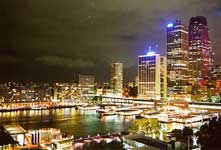 Circular Quay is the hub of Sydney. It was the center of Australia’s first European colony, and even today, it is still the place where Sydneysiders congregate on special occasions. On a warm, sunny Sydney day, there are few greater pleasures than idly wandering around the foreshores of Sydney Cove. It is a delightful way to see the harbor, the bridge, the Opera House, and the harbor foreshores.
Circular Quay is the hub of Sydney. It was the center of Australia’s first European colony, and even today, it is still the place where Sydneysiders congregate on special occasions. On a warm, sunny Sydney day, there are few greater pleasures than idly wandering around the foreshores of Sydney Cove. It is a delightful way to see the harbor, the bridge, the Opera House, and the harbor foreshores.
Centrepoint Tower
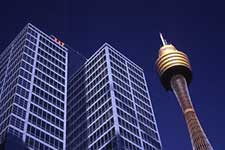 One of those tourist “things” that everyone visiting Sydney should do is take the lift to the top of Centrepoint Tower. The views from the observation deck are remarkable, and give every visitor an understanding of the structure of the city. Views are to the north across Sydney Harbour, to the west across to the Blue Mountains, to the south across Botany Bay and Sydney Airport toward the Royal National Park, and east to the Harbour Heads and the Pacific Ocean. Located at 100 Market Street, it is open every day and night.
One of those tourist “things” that everyone visiting Sydney should do is take the lift to the top of Centrepoint Tower. The views from the observation deck are remarkable, and give every visitor an understanding of the structure of the city. Views are to the north across Sydney Harbour, to the west across to the Blue Mountains, to the south across Botany Bay and Sydney Airport toward the Royal National Park, and east to the Harbour Heads and the Pacific Ocean. Located at 100 Market Street, it is open every day and night.
Darling Harbour
 Darling Harbour is Sydney’s equivalent of San Francisco’s Fisherman’s Wharf. It is a large complex of hotels, museums, gift shops, restaurants, and fast food eateries, and provides a constant parade of entertainment set against the backdrop of the harbor. The major attractions include the monorail, the National Maritime Museum, the Sydney Aquarium, Jordan’s Seafood Restaurant, the Exhibition Center, the Chinese Garden, the Sydney Entertainment Center, the Harris Street Motor Museum, and the Powerhouse Museum. It is open from 8:30 AM to 5:00 PM. For details, contact tel: 9286 0111.
Darling Harbour is Sydney’s equivalent of San Francisco’s Fisherman’s Wharf. It is a large complex of hotels, museums, gift shops, restaurants, and fast food eateries, and provides a constant parade of entertainment set against the backdrop of the harbor. The major attractions include the monorail, the National Maritime Museum, the Sydney Aquarium, Jordan’s Seafood Restaurant, the Exhibition Center, the Chinese Garden, the Sydney Entertainment Center, the Harris Street Motor Museum, and the Powerhouse Museum. It is open from 8:30 AM to 5:00 PM. For details, contact tel: 9286 0111.
Chinatown
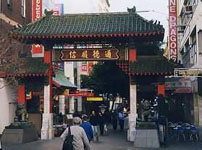 Just beyond Darling Harbour is Sydney’s Chinatown. Chinatown is a popular center for Australian Chinese and for more recent immigrants and students from Southeast Asia. The Chinese Gardens at the northern end of Chinatown and at the southern end of the Darling Harbour complex are a symbol of the involvement of the Chinese in Australian life. This traditional Chinese garden, reputedly the largest of its type outside China, is based on gardening principles that date back to the 5th century. It is designed as a place of peacefulness and tranquility, with miniature mountains, lakes, waterfalls, forests, and flowers. It has been constructed so that each vantage point offers an image of China in miniature. It is open daily from 9:30 to sunset.
Just beyond Darling Harbour is Sydney’s Chinatown. Chinatown is a popular center for Australian Chinese and for more recent immigrants and students from Southeast Asia. The Chinese Gardens at the northern end of Chinatown and at the southern end of the Darling Harbour complex are a symbol of the involvement of the Chinese in Australian life. This traditional Chinese garden, reputedly the largest of its type outside China, is based on gardening principles that date back to the 5th century. It is designed as a place of peacefulness and tranquility, with miniature mountains, lakes, waterfalls, forests, and flowers. It has been constructed so that each vantage point offers an image of China in miniature. It is open daily from 9:30 to sunset.
Toronga Zoo
 Voted the best international zoo in 1992, Taronga Zoo has superb views over Sydney Harbour and a substantial collection of Australian native fauna. The zoo can be reached by ferry from Wharf 2, Circular Quay (the journey takes twelve minutes), or by bus from the bus terminals at Wynyard or St Leonards railway stations. Open from 9:00 AM to 5.00 PM every day of the year, the displays include echidnas, dingoes, wombats, kangaroos, wallabies, and Australian snakes and spiders.
Voted the best international zoo in 1992, Taronga Zoo has superb views over Sydney Harbour and a substantial collection of Australian native fauna. The zoo can be reached by ferry from Wharf 2, Circular Quay (the journey takes twelve minutes), or by bus from the bus terminals at Wynyard or St Leonards railway stations. Open from 9:00 AM to 5.00 PM every day of the year, the displays include echidnas, dingoes, wombats, kangaroos, wallabies, and Australian snakes and spiders.
Kings Cross
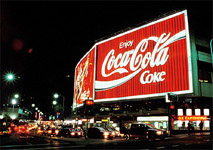 The most famous, or infamous, of all the inner city areas is Kings Cross, Sydney’s equivalent to London’s Soho. In the 1930s, Kings Cross was the center of the city’s bohemian community. This continued up to the 1960s, when “the Cross,” as it was affectionately known, was still a strange and wonderful mixture of high-class hotels, bohemians, classy nightclubs, and quality restaurants. Today, the Cross is still a tourist attraction with many excellent hotels and fine restaurants. In the daytime, the leafy parks and tree-lined streets, the smell of coffee from the numerous excellent coffee lounges and eateries, and the attractiveness of the El Alamein fountain are all magnets. Victoria Street to the south of the Kings Cross tunnel has some outstanding places to eat, and its cafes offer some of the best coffee in Sydney.
The most famous, or infamous, of all the inner city areas is Kings Cross, Sydney’s equivalent to London’s Soho. In the 1930s, Kings Cross was the center of the city’s bohemian community. This continued up to the 1960s, when “the Cross,” as it was affectionately known, was still a strange and wonderful mixture of high-class hotels, bohemians, classy nightclubs, and quality restaurants. Today, the Cross is still a tourist attraction with many excellent hotels and fine restaurants. In the daytime, the leafy parks and tree-lined streets, the smell of coffee from the numerous excellent coffee lounges and eateries, and the attractiveness of the El Alamein fountain are all magnets. Victoria Street to the south of the Kings Cross tunnel has some outstanding places to eat, and its cafes offer some of the best coffee in Sydney.
Oxford Street
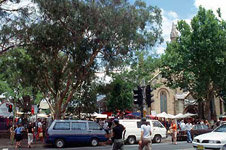 Oxford Street is what Kings Cross used to be. It is the heart of Sydney’s nightlife—a wonderful strip of hotels, nightclubs, restaurants, late night bookshops, cinemas, and coffee lounges where people who have no trouble partying until dawn gather, promenade, and generally enjoy themselves.
Oxford Street is what Kings Cross used to be. It is the heart of Sydney’s nightlife—a wonderful strip of hotels, nightclubs, restaurants, late night bookshops, cinemas, and coffee lounges where people who have no trouble partying until dawn gather, promenade, and generally enjoy themselves.
Historically, the street has long been associated with the city’s large gay community. A decade ago, it was an almost exclusively gay domain, with hotels like the Exchange and the Albury being well known gay hangouts.
Botanic Gardens
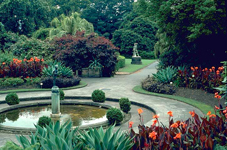 Sydney’s Royal Botanic Gardens are a truly beautiful and cool retreat in the heart of the city. The gardens have over 4,000 trees and plants from all over the world. There are specialist collections in the herbarium and the pyramid glasshouse, where the heat and humidity support an outstanding mixture of tropical and sub-tropical plants.
Sydney’s Royal Botanic Gardens are a truly beautiful and cool retreat in the heart of the city. The gardens have over 4,000 trees and plants from all over the world. There are specialist collections in the herbarium and the pyramid glasshouse, where the heat and humidity support an outstanding mixture of tropical and sub-tropical plants.
Art Gallery
 The Art Gallery of New South Wales has representative examples of artwork ranging from a substantial Aboriginal collection, to modern Australian masters, to excellent examples of the country’s finest colonial artists. Of particular interest are the works of Conrad Martens (Australia’s answer to J.M.W. Turner). The gallery also contains works by European masters, including Picasso and Rembrandt.
The Art Gallery of New South Wales has representative examples of artwork ranging from a substantial Aboriginal collection, to modern Australian masters, to excellent examples of the country’s finest colonial artists. Of particular interest are the works of Conrad Martens (Australia’s answer to J.M.W. Turner). The gallery also contains works by European masters, including Picasso and Rembrandt.
Mitchell Library
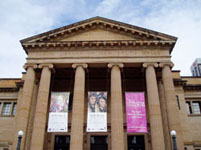 Known to Sydneysiders as the Mitchell Library, the State Library of New South Wales is the state’s major repository of historic documents, sketches, and information. The centerpiece of this interesting combination of old and new buildings is the Mitchell Library, the largest collection of colonial Australiana in the world.
Known to Sydneysiders as the Mitchell Library, the State Library of New South Wales is the state’s major repository of historic documents, sketches, and information. The centerpiece of this interesting combination of old and new buildings is the Mitchell Library, the largest collection of colonial Australiana in the world.
Hyde Park
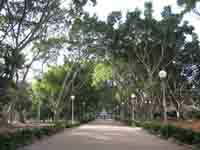 Hyde Park is the city’s central open space. Originally the site of the city’s first racecourse in the early 19th century, it was established as Hyde Park in the early years of the 20th century. Spread over sixteen hectares (39.5 acres) and divided by Park Street, the dominant feature of the southern section is the New South Wales War Memorial and the dominant feature of the northern section is the Archibald Fountain.
Hyde Park is the city’s central open space. Originally the site of the city’s first racecourse in the early 19th century, it was established as Hyde Park in the early years of the 20th century. Spread over sixteen hectares (39.5 acres) and divided by Park Street, the dominant feature of the southern section is the New South Wales War Memorial and the dominant feature of the northern section is the Archibald Fountain.
The War Memorial is an art deco construction that stands thirty meters above the Pool of Remembrance. There is a Hall of Memory and a Hall of Silence. The War Memorial is open during the day. There is an exhibition of photographs of Australians at War in the exhibition space underneath the building. For more information, contact (02) 9267 7668.
Queen Victoria Building
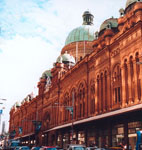 Pierre Cardin, the famous French designer, is reputed to have described the Queen Victoria Building (known to Sydneysiders as “the QVB”) as “the most beautiful shopping center in the world.” The building, which connects Town Hall railway station with Market Street in the city center, is architecturally magnificent. Built in 1898 and designed to resemble a Byzantine palace, it spent decades in a state of serious disrepair. Threatened with demolition in 1959, it was restored at a cost of $75 million and re-opened in 1982. It is open seven days a week.
Pierre Cardin, the famous French designer, is reputed to have described the Queen Victoria Building (known to Sydneysiders as “the QVB”) as “the most beautiful shopping center in the world.” The building, which connects Town Hall railway station with Market Street in the city center, is architecturally magnificent. Built in 1898 and designed to resemble a Byzantine palace, it spent decades in a state of serious disrepair. Threatened with demolition in 1959, it was restored at a cost of $75 million and re-opened in 1982. It is open seven days a week.
The Australian Museum
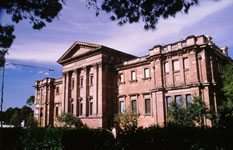 The Australian Museum, the nation’s oldest and largest natural history museum, is located at 6 College Street near Hyde Park. Its displays of Australian flora and fauna are considered the finest in the country, and some experts have rated it as one of the world’s top natural history museums. It is the repository for over eight million pieces. Of particular interest are the permanent exhibitions on Aboriginal Australia and local mammals, birds, and insects. There is also an excellent and hugely popular dinosaur display. The museum is open seven days from 9:30 AM to 5:00 PM
The Australian Museum, the nation’s oldest and largest natural history museum, is located at 6 College Street near Hyde Park. Its displays of Australian flora and fauna are considered the finest in the country, and some experts have rated it as one of the world’s top natural history museums. It is the repository for over eight million pieces. Of particular interest are the permanent exhibitions on Aboriginal Australia and local mammals, birds, and insects. There is also an excellent and hugely popular dinosaur display. The museum is open seven days from 9:30 AM to 5:00 PM
Powerhouse Museum
 Powerhouse Museum is an outstanding science, arts, and technology museum with exhibits ranging from New South Wales’s first steam train to the huge Boulton and Watt steam engine that was built in 1780 at the beginning of the Industrial Revolution. The museum also includes exhibitions of furniture, clothing, and aircraft, and it has special areas for children, regular specialist exhibitions, and a restaurant decorated by the popular Australian artist Ken Done.
Powerhouse Museum is an outstanding science, arts, and technology museum with exhibits ranging from New South Wales’s first steam train to the huge Boulton and Watt steam engine that was built in 1780 at the beginning of the Industrial Revolution. The museum also includes exhibitions of furniture, clothing, and aircraft, and it has special areas for children, regular specialist exhibitions, and a restaurant decorated by the popular Australian artist Ken Done.
The museum’s decorative arts displays include historic costumes, a Wedgwood collection, and some fine examples of Thomas Hope furniture. The space technology display combines pieces from the USA, USSR, and Chinese space programs, including a Saturn V rocket launcher and a replica lunar lander module.
Australian National Maritime Museum
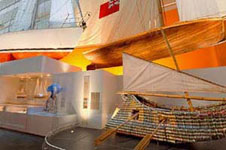 Located at the northern end of Darling Harbour, the Australian National Maritime Museum is designed as a comprehensive overview of Australia’s relationship with the sea. The museum is organized with sections devoted to six themes in Australian maritime history. The museum is open from 10:00 AM to 5:00 PM every day.
Located at the northern end of Darling Harbour, the Australian National Maritime Museum is designed as a comprehensive overview of Australia’s relationship with the sea. The museum is organized with sections devoted to six themes in Australian maritime history. The museum is open from 10:00 AM to 5:00 PM every day.
Museum of Contemporary Art
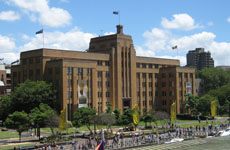 Located in the old art deco Customs Building on the western side of Circular Quay, the Museum of Contemporary Art offers an excellent cross-section of international contemporary art. Acknowledged masterpieces in the collection include Roy Lichtenstein’s Crying Girl and Robert Indiana’s Love. It has become one of the city’s cultural centers and holds lectures, films, and occasionally concerts. In addition, the MCA shop has an interesting collection of gifts and pieces of art. The museum is open from 11:00 AM to 6:00 PM every day.
Located in the old art deco Customs Building on the western side of Circular Quay, the Museum of Contemporary Art offers an excellent cross-section of international contemporary art. Acknowledged masterpieces in the collection include Roy Lichtenstein’s Crying Girl and Robert Indiana’s Love. It has become one of the city’s cultural centers and holds lectures, films, and occasionally concerts. In addition, the MCA shop has an interesting collection of gifts and pieces of art. The museum is open from 11:00 AM to 6:00 PM every day.
Tourist Information
Darling Harbour Visitor Information Centre
33 Wheat Rd. Darling Harbour
Sydney NSW 2000
Telephone: (02) 9240 8788
Fax: (02) 9252 8738
The Rocks Visitor Centre
106 George St. The Rocks
Sydney NSW 2000
Telephone: (02) 9240 8788
Fax: (02) 9252 8738